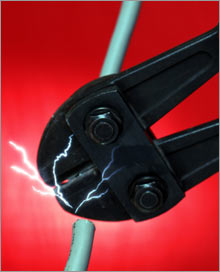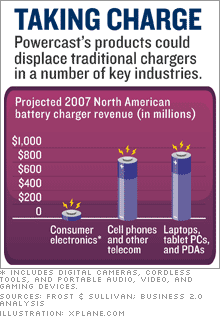Monday, May 5, 2008
"Innovation Journalism" -- What Is It?
Thursday, May 1, 2008
Cut the Cord: Wireless Electricity Comes to Market
_____________________________________
How much money could you make from a technology that replaces electrical wires? A startup called Powercast, along with the more than 100 companies that have inked agreements with it, is about to start finding out. Powercast and its first major partner, electronics giant Philips, are set to launch their first device powered by electricity broadcast through the air.
It may sound futuristic, but Powercast's platform uses nothing more complex than a radio--and is cheap enough for just about any company to incorporate into a product. A transmitter plugs into the wall, and a dime-size receiver (the real innovation, costing about $5 to make) can be embedded into any low-voltage device. The receiver turns radio waves into DC electricity, recharging the device's battery at a distance of up to 3 feet.



Picture your cell phone charging up the second you sit down at your desk, and you start to get a sense of the opportunity. How big can it get? "The sky's the limit," says John Shearer, Powercast's founder and CEO. He estimates shipping "many millions of units" by the end of 2008.
For years, electricity experts said this kind of thing couldn't be done. "If you had asked me seven months ago if this was possible, I would have said, 'Are you dreaming? Have you been smoking something?'" says Govi Rao, vice president and general manager of solid-state lighting at Philips (Charts). "But to see it work is just amazing. It could revolutionize what we know about power."
So impressed was Rao after witnessing Powercast's demo last summer that he walked away jotting down a list of the industries to which the technology could immediately be applied: lighting, peripherals, all kinds of handheld electronics. Philips partnered with Powercast last July, and their first joint product, a wirelessly powered LED light stick, will hit the market this year. Computer peripherals, such as a wireless keyboard and mouse, will follow in 2008.
Broadcasting power through the air isn't a new idea. Researchers have experimented with capturing the radiation in radio frequency at high power but had difficulty capturing it at consumer-friendly low power. "You'd have energy bouncing off the walls and arriving in a wide range of voltages," says Zoya Popovic, an electrical engineering professor at the University of Colorado who works on wireless electricity projects for the U.S. military.
That's where Shearer came in. A former physicist based in Pittsburgh, he and his team spent four years poring over wireless electricity research in a lab hidden behind his family's coffee house. He figured much of the energy bouncing off walls could be captured. All you had to do was build a receiver that could act like a radio tuned to many frequencies at once.
"I realized we wanted to grab that static and harness it," Shearer says. "It's all energy."
So the Powercast team set about creating and patenting that receiver. Its tiny but hyperefficient receiving circuits can adjust to variations in load and field strength while maintaining a constant DC voltage. Thanks to the fact that it transmits only safe low wattages, the Powercast system quickly won FCC approval--and $10 million from private investors.
Powercast says it has signed nondisclosure agreements to develop products with more than 100 companies, including major manufacturers of cell phones, MP3 players, automotive parts, temperature sensors, hearing aids, and medical implants.
The last of those alone could be a multibillion-dollar market: Pacemakers, defibrillators, and the like require surgery to replace dead batteries. But with a built-in Powercast receiver, those batteries could last a lifetime.
"Everyone's looking to cut that last cord," says Alex Slawsby, a consultant at Innosight who specializes in disruptive innovation. "Think of the billion cell phones sold last year. If you could get Powercast into a small percentage of the high-end models, those would be huge numbers."
Could Powercast's technology also work for larger devices? Perhaps, but not quite yet. Laptop computers, for example, use more than 10 times the wattage of Powercast transmissions.
But industry trends are on Shearer's side: Thanks to less energy-hungry LCD screens and processors, PC power consumption is slowly diminishing. Within five years, Shearer says, laptops will be down to single-digit wattage--making his revenue potential even more electrifying.
Originally published in Business 2.0 magazine.
The $64,000 Question: Will the Cancer Recur?
Two teams of cancer researchers have made discoveries that, if they pan out, could provide a crystal ball to predict which cancers are most likely to spread, and provide an answer to every cancer patient's $64,000 question: Will I be cured, or will the cancer come back?
- Researchers at Johns Hopkins Kimmel Cancer Center have discovered genetic markers, clearly visible in tissue samples, that can identify which early-stage lung tumors are likely to recur within 5 years.
- A team of scientists based in the Life Sciences Division of the Lawrence Berkeley National Laboratory have discovered that a naturally occurring protein known as SATB1 appears to have the power to reprogram breast cancer tumors, turning them into the aggressive type that metastasize, or spread.
While both discoveries are still in an early stage of research, both have clear potential to lead to new diagnostic tools as well as new approaches to treatment. Patients whose lung tumors show the molecular "flags" identified by the Hopkins team or whose breast tumors test positive for SATB1 might be reclassified as high-risk and treated as such. Such knowledge could be powerful -- and scary.
Would you want to know, even if the news wasn't good?


